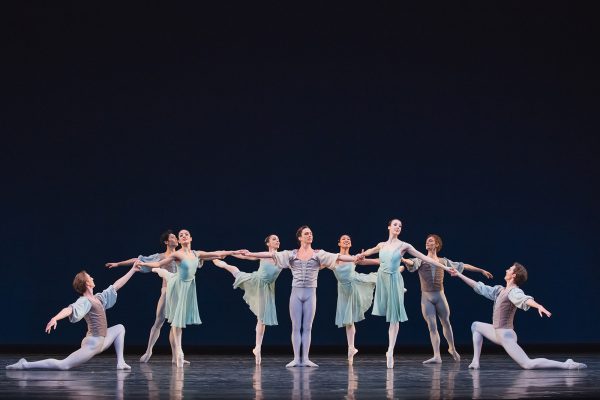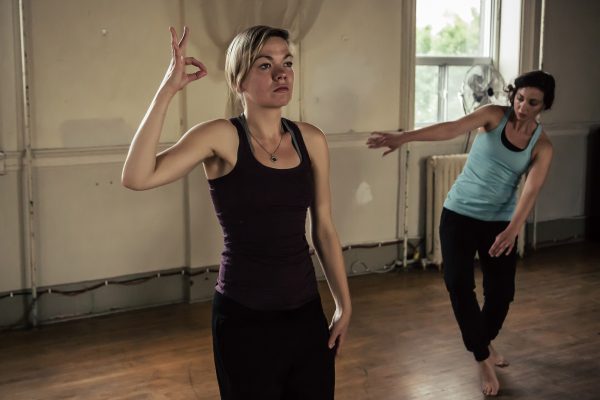I never took calculus and I’m not sure I regret it. Growing up disdainful of schooling, I was partial to the argument of pragmatists: how exactly will becoming adept in the nuances of parabolas make me a better citizen of the world? No matter how many times I exclaimed it, I never heard a rebuttal that changed my mind. It was large-scale coercion, said my teenage brain — I was sure of it. But when Peggy Baker Dance Project’s newest world premiere became my latest assignment, the good old days of tenth grade activism seemed much less noble. When a cursory online search for Baker’s locus plot yielded promotional images where each letter of the modest, yet loaded, title was rendered graphically by a mathematic symbol of comparable shape, I got nervous. But then I remembered: these are the same obscure signs Matt Damon scrawled on that chalkboard in Good Will Hunting. These signs allude to value and effect, probability and dimension; they state scientific truisms that, whether I like it or not, are important players in quantifying the world and how we exist in it.
While (thankfully) not a physicalized ode to quests for empirical knowledge, locus plot excels as a poetic transposition of chemistry in its humanist and even larger-than-life form, and the beginning of the full-length work illustrates this perfectly. As the lights come up on musician, and master of composition, John Kameel Farah seated at a Steinway, viewers begin to clock the small laboratory of instruments used in crafting electronic music positioned abundantly around him. As the score begins, slowly and subtly fusing classical notes with tonal manipulation, Farah’s musical hypotheses conjure the work’s ensemble of five dancers to walk calmly on stage. After arriving around the center of the space, dotting the floor in a comfortably close pentagram, they wait for a time before shifting in a variation of the same configuration, one, two or three steps at a time, but always beginning and ending in unison. The sense is that these empathetic and mobile postures, these mise-en-scènes, consist of five intimately familiar bodies quietly co-authoring an experiment of some kind as their unit oscillates across the stage. This acute sensitivity to action and reaction is pervasive throughout the work, as Baker’s movement vocabulary and its articulate execution by her company leave the viewers’ eyes working hard to refocus in an effort to catch it all. As the full expanse of each dancer’s instrument is made abundantly visible, their ferocious speed renders each swooping, bounding and entangled gesture into a trace of light, denoting what came before, but moving quickly onto the next. Had any of locus plot been the cornerstone for geometry instead of vice versa, I might have considered a protractor’s arc as something more significant, and beautifully bountiful, than a metal stick that happened to poke me a lot.
The production’s design owes much to Marc Parent’s lighting, consistently fostering a distinctly spacious ether, one that seemed not dissimilar to the galactic cutaways in Terrence Malick’s Tree of Life, providing a very different location to consider as an epicentre of action. Baker’s dancers — Ric Brown, Sarah Fregeau, Kate Holden, Sean Ling and Sahara Morimoto — embody this allusion in earnest, as one by one the dancers convey the effect of a quieted star, bursting occasionally but always in flight. The sectional work performed by the Fregeau, Holden and Morimoto, masters of physics in both concept and execution, do just this — they appear to lift off, only stopping short for modesty’s sake.
Farah’s score continues to intensify as the dancers calibrate the audience to digest more and more stimuli. At one point, I heard the distinct sound of a hummingbird’s flight, every so often crossing paths mid-air with one of its ilk. Likewise, the work’s use of vocalization, emitted by all of the dancers though more often just one at a time, also supported a valuable upper end to locus plot’s spectrum of dynamism, one which is hard-pressed to match with a silent body, no matter its strength. The ensemble’s vocal power might best be described as the guttural exclamation when exasperation leaps out of us, only magnified; alarming, yet familiar.
Throughout the work, the viewer is reminded of Baker’s notes during the pre-show chat, one of which was the reference to visual mathematical renderings that inspired the project, some of which make cameos throughout the performance when they’re projected above the action. Unfortunately, these haphazard sketches of parabolas (I swear to you), equations and other glyphs denoting the scientific language we’ve come to recognize as the mother tongue of certainty appear tokenist, practically caricatures of the work as opposed to coordinates of its birthplace, and are dwarfed by the unassuming expanse of the Betty Oliphant Theatre. Another aspect that Baker touches on, and one that delivers throughout the work, is the reference to the tangential nature of sequence and events. In dance, not unlike science, the unexpected gives birth to revelation, which in turn propels itself into a never-ending chain reaction of discovery. More than fittingly, the tenuous physics the dancers in locus plot negotiate onstage promote an array of tangential narratives that, as Baker suggests and as I witnessed, emerge just as easily as they collapse back into themselves.~
Tagged: Choreography, Contemporary, ON , Toronto





